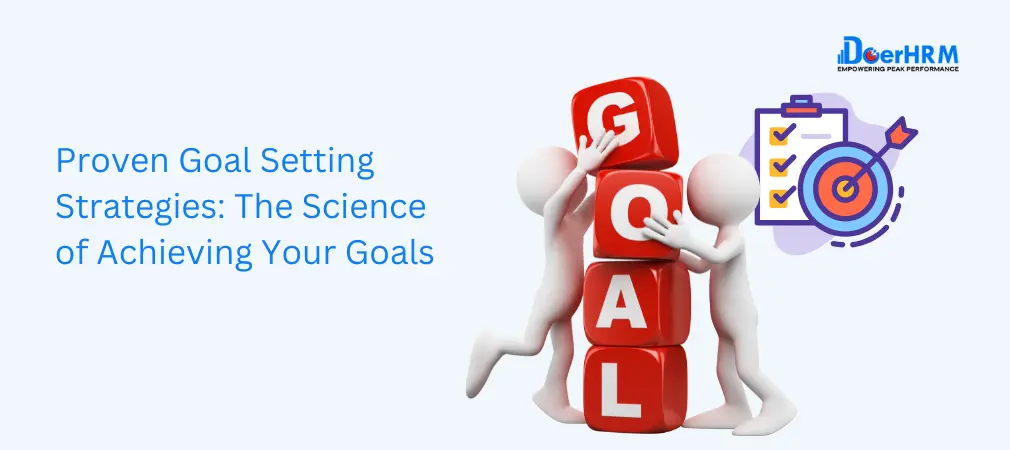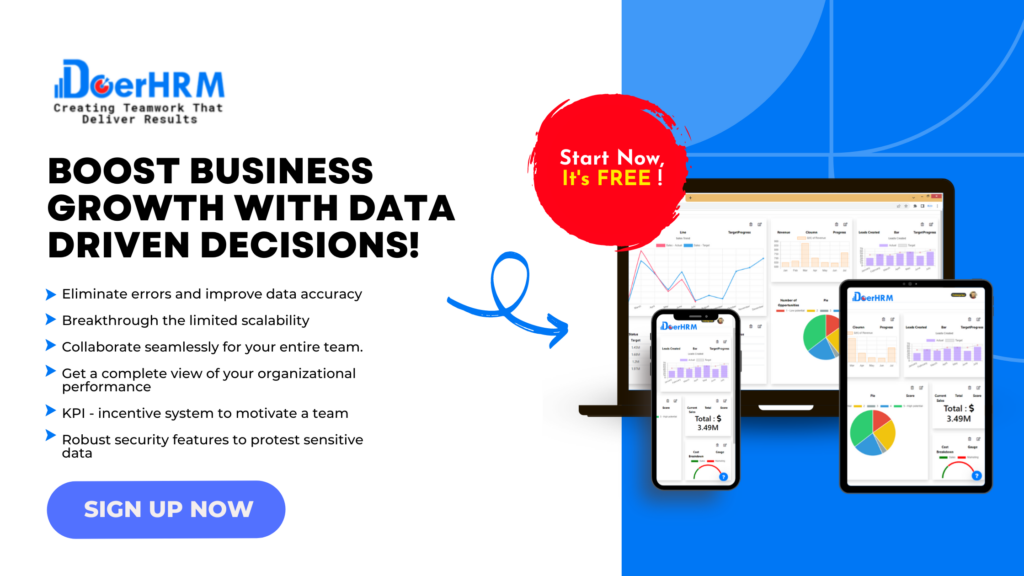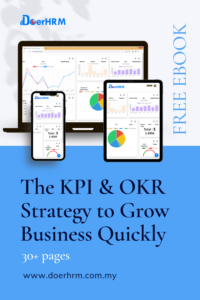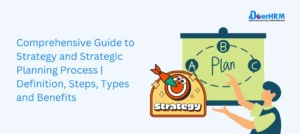Overview:
Goal setting is an essential part of personal and professional growth. While modern culture often highlights the importance of achieving milestones, it rarely delves into the science behind setting and achieving goals. This guide bridges that gap, offering practical strategies to help you set and accomplish objectives effectively. Whether for personal development or career success, the insights here will empower you to excel.
According to research from Harvard Business Review, people who set specific goals are 10 times more likely to succeed than those who don’t. That’s why organizations invest in goal setting frameworks—because they know structure fuels results.
Table of Contents
I. What is Goal Setting?
Definition and Perspective:
Goal setting involves identifying a target or objective to achieve. However, an equally important question to ask is, “What tradeoffs am I willing to make?” Achieving meaningful goals requires embracing the sacrifices and effort necessary to attain them.
For example, while many aspire to write a best-selling book or win a gold medal, few are willing to endure the challenges these goals entail. Thus, goal setting is not just about the rewards but also about accepting the costs involved.
Rudders and Oars:
Imagine a rowboat: goals are the rudder that sets direction, while the oars represent the processes that drive progress. A rudder without movement is useless, just as direction without effort leads nowhere. This metaphor highlights the distinction between goals (setting direction) and systems (ensuring progress). For instance:
- A coach aims to win a championship (goal) but relies on daily practice routines (system).
- A writer’s goal might be to complete a novel, but success depends on a consistent writing schedule.
Key Insight: Goals set direction; systems ensure progress. To succeed, you must not only steer but also row consistently.
II. How to Set Goals You’ll Follow
1. Ruthlessly Eliminate Other Goals:
One of the greatest obstacles to achieving a goal is competing objectives. Psychologists call this “goal competition.” Every additional goal divides your focus and energy. By concentrating on one priority at a time, you maximize your chances of success.
Like a rose bush that requires pruning to bloom fully, your goals need trimming. Focus on fewer, more meaningful objectives to make substantial progress. Consider these prioritization methods:
- The Ivy Lee Method
- Warren Buffett’s 25-5 Rule
- The Eisenhower Box
- The 20 Slot Rule
- The Myth of Multitasking
2. Stack Your Goals:
Implementation intentions—specific plans about when, where, and how you will act—boost your chances of success. Habit stacking is a powerful way to achieve this:
- After [current habit], I will [new habit].
Examples:
- Meditation: After brewing coffee, meditate for one minute.
- Exercise: Before showering, do 10 pushups.
- Gratitude: Before dinner, express one thing you’re grateful for.
Habit stacking turns intentions into daily habits, bridging the gap between abstract goals and actionable systems.
3. Set an Upper Bound:
Most goals emphasize minimum thresholds, e.g., “I want to lose at least 5 pounds this month.” Adding an upper limit ensures sustainability, e.g., “I want to lose 5-10 pounds.”
By setting boundaries, you create a balanced approach that avoids burnout while fostering consistent progress. Early in the habit-building process, showing up matters more than excelling. Upper bounds encourage long-term success by prioritizing sustainability.
III. How to Achieve Your Goals Consistently
Align Your Environment:
Your environment plays a critical role in goal achievement. People tend to make decisions based on default options:
- If your phone is by your bed, checking social media becomes the default.
- If your kitchen is stocked with junk food, unhealthy eating is likely.
- Conversely, keeping workout equipment nearby encourages exercise.
Strategies to design supportive environments:
- Simplify: Remove distractions. A clutter-free space fosters focus.
- Visual Cues: Use triggers like the Paper Clip Method or Seinfeld Strategy to remind you of your goals.
- Opt-Out Systems: Schedule commitments in advance to make participation the default (e.g., booking workouts).
Measure Your Goals:
Measurement provides critical feedback, offering insights into progress and motivating continued effort. Track your performance to ensure you’re on course. Examples:
- Counting pushups to build strength.
- Logging daily reading to enhance learning.
- Tracking integrity by recording core values.
Key Techniques:
- Paper Clip Strategy: Track progress with a simple visual marker.
- Measure Backward, Not Forward: Reflect on improvements over time.
- Seinfeld Strategy: Maintain consistency by building a streak.
Effective goal setting requires aligning ambitions with practical systems. By focusing on a clear direction, implementing supportive habits, and creating an environment conducive to success, you can turn aspirations into achievements. Measure your progress, embrace the necessary tradeoffs, and commit to sustainable practices for long-term growth.
For more actionable strategies, explore additional resources on goal setting and personal development.
Back to Basics: Understanding Goal-Setting Theory
The goal-setting theory, developed by Edwin Locke and Gary Latham in 1990, establishes a strong link between setting well-defined goals and improving performance. According to this theory, specific and structured goals help individuals focus, apply consistent effort, and stay persistent, which boosts productivity.
For goal-setting to be effective, five key elements must be in place:
- Clarity: Goals should be specific and measurable, giving employees a clear understanding of their objectives.
- Challenge: Goals need to be ambitious yet achievable to motivate employees without overwhelming them.
- Commitment: Employees must believe in and commit to the goals they are working toward.
- Feedback: Providing feedback ensures employees know how they’re performing and what adjustments are needed.
- Task Complexity: Goals should come with realistic timelines that account for the difficulty and learning involved.
What Is a Goal-Setting Process?
A goal-setting process is a systematic approach for organizations to define and achieve their desired outcomes. It creates clarity, fosters motivation, and instills accountability among employees by outlining clear objectives and actionable steps.
Why Goal-Setting Matters
An effective goal-setting process offers significant benefits for organizations of any size:
1. Provides Clear Direction
Goal-setting helps employees align their daily tasks with the organization’s core objectives. Leadership can use goals to guide teams toward areas that matter most, preventing them from expending energy on non-essential activities.
2. Enhances Motivation
When employees are actively involved in setting measurable goals, they are more motivated to overcome challenges. Tracking progress through milestones and short-term objectives creates a sense of achievement and keeps employees engaged as they work toward their ultimate goal.
3. Promotes Accountability
Well-defined goals establish clear deadlines and benchmarks. Employees can monitor their progress, ensuring they remain on track to meet their objectives.
4. Boosts Employee Performance
A structured goal-setting framework helps employees focus on what’s important, improving productivity. Research published in the Journal of Leadership & Organizational Studies highlights the positive correlation between employees’ commitment to goals and their performance.
5. Helps Identify Obstacles
Consistently comparing performance against goals allows organizations to identify strengths, weaknesses, and areas for improvement. This enables timely course corrections to stay aligned with overall objectives.
Types of Goals in Goal-Setting
When setting goals, organizations can choose from various types depending on scope, duration, and complexity:
Process, Performance, and Outcome Goals
- Process Goals: Focus on the methods or strategies used to achieve performance goals.
- Performance Goals: Short-term objectives that contribute to achieving the overall outcome.
- Outcome Goals: The overarching end results being pursued.
Short-Term and Long-Term Goals
- Short-Term Goals: Objectives to be accomplished in the near future, contributing to broader goals.
- Long-Term Goals: Ambitious goals that require more time and planning, rooted in the organization’s values.
Individual and Shared Goals
- Individual Goals: Tailored to employees’ personal and professional growth while aligning with organizational objectives.
- Shared Goals: Promote teamwork and collaboration, leveraging collective strengths for better outcomes.
Qualitative and Quantitative Goals
- Qualitative Goals: Assessed subjectively, based on experiences or perceptions.
- Quantitative Goals: Measurable and defined by specific metrics or outcomes.
Popular Goal-Setting Frameworks
Choosing the right framework can make goal-setting more effective. Below are some widely used methodologies:
- SMART Goals: Define goals that are Specific, Measurable, Achievable, Realistic, and Timely.
- OKRs: Focus on Objectives and Key Results to promote transparency and resource alignment.
- KPIs: Use Key Performance Indicators to measure progress across various business areas.
- Backward Goal-Setting: Start with the end goal and work backward to outline necessary milestones.
- MBO (Management by Objectives): Managers define objectives that cascade through the organization for alignment and execution.
- BHAG: Big, Hairy, Audacious Goals set ambitious, long-term targets to inspire teams.
- 4DX (Four Disciplines of Execution): Prioritize key goals, measure progress with lead indicators, and maintain accountability through scorecards.
- EOS (Entrepreneurial Operating System): A holistic approach for small and medium-sized businesses focusing on vision, people, data, processes, traction, and problem-solving.
- Balanced Scorecard (BSC): Translates mission and vision into actionable objectives across financial, customer, internal process, and growth perspectives.
Related: What Is A KPI & How To Develop It Effectively
Related: OKRs vs Balance Scorecards
Steps to an Effective Goal-Setting Process
Follow these seven steps to ensure your goals are well-defined and achievable:
- Define Your Goals: Identify what you aim to achieve and why it matters.
- Document Your Goals: Writing goals down enhances clarity and commitment.
- Measure Progress: Determine metrics for success, using tools like KPIs or OKRs.
- Anticipate Obstacles: Identify potential challenges and plan solutions in advance.
- Set a Timeline: Establish milestones and deadlines to keep progress on track.
- Develop a Plan: Create a detailed roadmap with specific actions and habits.
- Track Progress: Regularly review progress to stay aligned and make necessary adjustments.
Related: How To Improve A Data-Driven Learning Plan & What Training KPIs To Monitor
Tips for Successful Goal-Setting
- Align Goals with Company Objectives: Ensure all goals tie into broader organizational strategies.
- Make Goals Visible: Keep goals in sight to maintain focus and commitment.
- Foster Commitment: Highlight the importance of goals and instill confidence in employees.
- Incorporate Rewards: Recognize achievements to motivate employees and improve retention.
Effective goal-setting drives accountability, productivity, and success. By selecting the right frameworks and following structured steps, organizations can create a seamless process for achieving their objectives.
Tools like Quantive empower modern businesses to connect strategy with execution, ensuring continuous improvement and long-term growth. By adopting a goal-driven approach, companies can navigate challenges, adapt to changes, and achieve remarkable outcomes.
How to Write SMART Goals: A Guide for Managers and Employees
SMART goals are specific statements outlining the critical results you aim to achieve. These goals are designed to foster a mutual understanding of what constitutes successful performance and professional development.
What Does SMART Stand For?
- S: Specific – What will be accomplished? What actions will you take?
- M: Measurable – What data will measure the goal? (How much? How well?)
- A: Achievable – Is the goal realistic? Do you have the skills and resources needed?
- R: Relevant – How does the goal align with broader objectives? Why is the result important?
- T: Time-Bound – What is the deadline for achieving the goal?
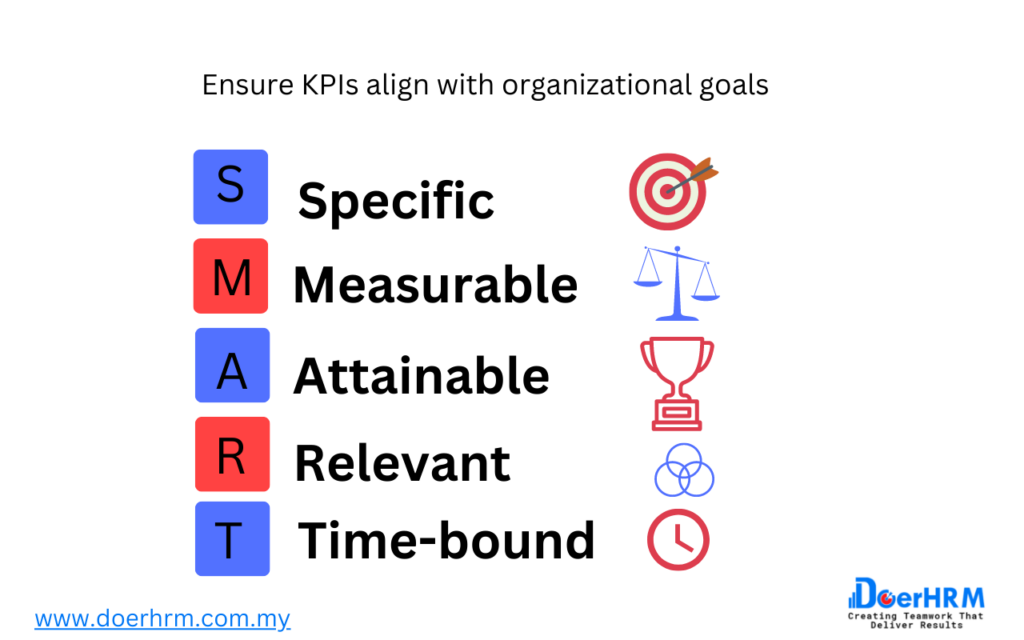
Determining the Right Scope for SMART Goals
SMART goals should encompass all significant responsibilities in your role. They are designed to focus attention and resources on high-priority tasks that will help achieve your key objectives. SMART goals should align with your day-to-day job responsibilities.
Common Types of Goals:
- Increase something
- Create something
- Improve something
- Reduce something
- Save something
- Develop yourself or others
Steps to Begin Setting SMART Goals
- Reflect on your overall job responsibilities and identify the major areas for which you are accountable.
- Create goal statements for each key area, focusing on end results rather than tasks.
- Ensure goals are broad enough to cover your primary outcomes but specific enough to measure success.
- Incorporate ongoing responsibilities and any new projects, priorities, or initiatives relevant to the current performance cycle.
- Avoid setting too many goals, as this may indicate an overly task-oriented focus. If necessary, combine related goals into broader outcome areas.
Writing SMART Goals
Specific
Clearly define what you want to accomplish. Think of this as the mission statement for your goal. Address the following questions:
- Who needs to be involved?
- What exactly do you aim to accomplish?
- When will it occur?
- Where will it happen (if location-specific)?
- Which requirements or obstacles might affect the goal?
- Why is the goal important?
Examples of "Specific" Actions:
Use actionable verbs such as oversee, manage, develop, coordinate, implement, evaluate, etc. Avoid vague terms like “improve” or “increase,” which lack clarity about your role.
Measurable
Establish metrics to determine progress and success. Consider:
- What data or evidence will confirm achievement?
- Can milestones be identified to track progress?
- Are qualitative or quantitative measurements appropriate?
Examples of measurable data include:
- Productivity rates
- Quality/accuracy levels
- Customer satisfaction scores
- Revenue or cost savings
Achievable
Ensure the goal is realistic given your skills and resources. Consider:
- How will you achieve the goal?
- Do you have the tools and skills required? If not, identify what is needed to acquire them.
Relevant
Align goals with broader objectives. For instance, launching a program or initiative should support overall business priorities.
Time-Bound
Set a clear deadline. Ask:
- What is the timeframe for completing the goal?
- What intermediate milestones can track progress?
Simplifying SMART Goals
To write SMART goals effectively, ask yourself and your team detailed questions. Refine your strategy based on the answers to ensure the goals are clear and achievable. This process should provide clarity and motivation rather than feel overwhelming.
SMART Goal Examples
Example 1: Completing a Project
- Initial Goal: I want to complete a project.
- SMART Goal:
- Specific: Launch a mobile app to improve the customer experience on mobile devices.
- Measurable: Achieve 50,000 installs and a 5% conversion rate within six months.
- Achievable: All necessary departments have agreed to the project.
- Relevant: Enhancing the mobile experience aligns with the company’s core initiatives.
- Time-Bound: Launch the app by the end of June with a supporting marketing campaign.
- Milestone: Mobile app launches in June.
- Deadline: End of the fiscal year.
Example 2: Improving Personal Performance
- Initial Goal: I want to improve my performance.
- SMART Goal:
- Specific: Enhance PowerPoint skills to create efficient and professional presentations.
- Measurable: Be proficient in creating presentations with graphs, images, and templates within six months.
- Achievable: Use online courses and tutorials, and seek guidance from coworkers.
- Relevant: Mastering PowerPoint supports current and future job responsibilities.
- Time-Bound: Achieve proficiency by the next performance review.
- Milestone: Complete a PowerPoint course within three months.
- Deadline: Six months.
Writing SMART goals ensures clarity, alignment, and a clear path to success. Use the SMART framework to define, refine, and achieve your objectives effectively.
FAQs on Goal Setting
1. What is goal setting in simple terms?
2. Why is goal setting important in business?
3. What are the best goal setting frameworks?
4. How can I stay motivated with goal setting?
5. What’s the difference between goals and objectives?
At the end of the day, goal setting isn’t just about writing ambitions on paper—it’s about building the discipline, systems, and accountability to make them real. Without a structured approach, even the most motivated teams struggle to stay aligned and achieve meaningful results. That’s where DoerHRM comes in. Our software and training solutions turn strategies into actionable goals, trackable KPIs, and measurable progress, ensuring that every individual contributes to the bigger picture. If you’re serious about achieving more with less wasted effort, your next step is clear: connect with DoerHRM today, explore how our tools can transform your performance, and start hitting the goals that matter most.
